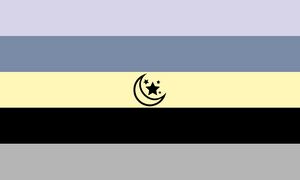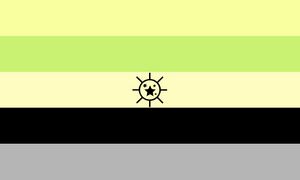Galactian system: Difference between revisions
No edit summary |
imported>Sekhet (Improved how sources are cited. Made wording clearer.) |
||
| Line 1: | Line 1: | ||
{{uncommon identity}} | {{uncommon identity}} | ||
{{infobox identity}} | {{infobox identity}} | ||
The ''' | The '''galactian system''' is an alternative classification system for [[nonbinary]] people based on their alignment in relation to the binary genders. It was created in 2016, in response to the trend that started in that year for nonbinary people to say whether they were "male-aligned" or "female-aligned," which meant that they were almost but not quite those genders. The downside of such "gender alignment language" (as pointed out by the creator of the galactian system, Tumblr user vergess) was that it amounts to saying that nonbinary people are really male or female, and to invalidate their gender. The galactian system tries to solve this instead using celestial imagery, in order to avoid concepts that are related to the [[gender binary]] system. These words were not coined to describe genders, but a relation towards a binary gender, an alignment. For instance, a [[genderless]] person may identify as female-aligned or lunarian because they have experiences in common with women, despite not considering [[singular they|themself]] a woman.<ref>vergess. "Describing alignment." ''kinda-girls'' (blog). November 16, 2016. Retrieved July 20, 2020. https://web.archive.org/web/20200720224831/https://kinda-girls.tumblr.com/post/153284340413/describing-alignment</ref> In the 2019 Gender Census, around 0.2% of respondents identified with a galactian alignment.<ref>[https://gendercensus.com/post/183843963445/gender-census-2019-the-worldwide-tldr Gender Census 2019 - the worldwide TL;DR]</ref> Galactian alignments are often used together with other gender identities, such as "solarian bigender" or "lunarian demigender". | ||
Galactian alignments are often used together with other gender identities, such as "solarian bigender" or "lunarian demigender". | |||
== Solarian == | == Solarian == | ||
The solarian identity | The solarian identity expresses a similarity with masculine genders, alignments, or experiences. It's a replacement for "masculine-aligned," "masc-aligned," or "male-aligned." The name of this identity comes from the fact that in many cultures, the sun is associated with masculinity and male energy.<ref name="stellunarian">bashana-haba-ah. "Anonymous asked: What's lunarian, stellarian and solarian?" ''Stellunarian'' (blog). A reblog made March 6, 2017 of a lost, deleted post. Retrieved September 2, 2018. https://web.archive.org/web/20180902205854/https://stellunarian.tumblr.com/post/158086623900/whats-lunarian-stellarian-and-solarian</ref> | ||
== Lunarian == | == Lunarian == | ||
The lunarian identity | The lunarian identity expresses a similarity with feminine genders, alignments, or experiences. It's a replacement for "feminine-aligned", "fem-aligned," or "female-aligned." The reason is that, in many cultures, the moon is associated with femininity.<ref name="stellunarian"/> | ||
== Stellarian == | == Stellarian == | ||
The stellarian identity | The stellarian identity expresses that a person does not feel similarity with with the gender binary. It expresses a nonbinary alignment, in contrast to feminine and masculine alignments. The reason for choosing the stars for this term is that there is a large number of different nonbinary identities and presentations, in the same way that there are many stars.<ref name="stellunarian"/> | ||
== Mixed alignments == | == Mixed alignments == | ||
| Line 18: | Line 16: | ||
== Other alignments == | == Other alignments == | ||
There is another galactian identity, called ''singularian'', which rejects any kind of relation with the gender binary, and therefore the alignment system itself. This is in contrast to stellarian, which aligns with neither male nor female within the system. Perhaps the greatest difference between the terms is that a singularian person rejects alignment entirely, and so will never identify as lunarian or solarian, while a stellarian person may identify as lunarian or solarian at different times or in different ways.<ref> | There is another galactian identity, called ''singularian'', which rejects any kind of relation with the gender binary, and therefore the alignment system itself. This is in contrast to stellarian, which aligns with neither male nor female within the system. Perhaps the greatest difference between the terms is that a singularian person rejects alignment entirely, and so will never identify as lunarian or solarian, while a stellarian person may identify as lunarian or solarian at different times or in different ways.<ref>Stellunarian. "Anonymous asked: Since this (very good) system is comparing alignment to celestial bodies, would voidian/voidarian/voidic be a black hole?" ''Stellunarian'' (blog). March 6, 2017. Retrieved April 20, 2020. https://web.archive.org/web/20200420171029/https://stellunarian.tumblr.com/post/158086230565/since-this-very-good-system-is-comparing</ref> | ||
Additionally, the prefix ''demi'' can be added to any of the galactian identities in order to express a partial identification with one of these identities (e.g. demisolarian, demilunarian, demisingularian...). Demi- alignments also receive proper names: | Additionally, the prefix ''demi'' can be added to any of the galactian identities in order to express a partial identification with one of these identities (e.g. demisolarian, demilunarian, demisingularian...). Demi- alignments also receive proper names: | ||
Revision as of 23:05, 20 July 2020
| |
This page is about a gender identity that is not widely used among gender-variant people. This does not mean that the identity is not valid, but that very few people are known to use this term. More information on uncommon identities... |
The galactian system is an alternative classification system for nonbinary people based on their alignment in relation to the binary genders. It was created in 2016, in response to the trend that started in that year for nonbinary people to say whether they were "male-aligned" or "female-aligned," which meant that they were almost but not quite those genders. The downside of such "gender alignment language" (as pointed out by the creator of the galactian system, Tumblr user vergess) was that it amounts to saying that nonbinary people are really male or female, and to invalidate their gender. The galactian system tries to solve this instead using celestial imagery, in order to avoid concepts that are related to the gender binary system. These words were not coined to describe genders, but a relation towards a binary gender, an alignment. For instance, a genderless person may identify as female-aligned or lunarian because they have experiences in common with women, despite not considering themself a woman.[1] In the 2019 Gender Census, around 0.2% of respondents identified with a galactian alignment.[2] Galactian alignments are often used together with other gender identities, such as "solarian bigender" or "lunarian demigender".
Solarian
The solarian identity expresses a similarity with masculine genders, alignments, or experiences. It's a replacement for "masculine-aligned," "masc-aligned," or "male-aligned." The name of this identity comes from the fact that in many cultures, the sun is associated with masculinity and male energy.[3]
Lunarian
The lunarian identity expresses a similarity with feminine genders, alignments, or experiences. It's a replacement for "feminine-aligned", "fem-aligned," or "female-aligned." The reason is that, in many cultures, the moon is associated with femininity.[3]
Stellarian
The stellarian identity expresses that a person does not feel similarity with with the gender binary. It expresses a nonbinary alignment, in contrast to feminine and masculine alignments. The reason for choosing the stars for this term is that there is a large number of different nonbinary identities and presentations, in the same way that there are many stars.[3]
Mixed alignments
A person can identify with more than one galactian identity, at the same time or in different situations. When this happens, they can be called eclipsian (solarian and lunarian, also known as sollunarian), nebularian (lunarian and stellarian, also known as stellunarian), novarian (stellarian and solarian, also known as solstellarian) or galaxian (solarian, lunarian and stellarian, also known as solstellunarian).
Other alignments
There is another galactian identity, called singularian, which rejects any kind of relation with the gender binary, and therefore the alignment system itself. This is in contrast to stellarian, which aligns with neither male nor female within the system. Perhaps the greatest difference between the terms is that a singularian person rejects alignment entirely, and so will never identify as lunarian or solarian, while a stellarian person may identify as lunarian or solarian at different times or in different ways.[4]
Additionally, the prefix demi can be added to any of the galactian identities in order to express a partial identification with one of these identities (e.g. demisolarian, demilunarian, demisingularian...). Demi- alignments also receive proper names:
- Demisolarian: dawnian
- Demilunarian: duskian
- Demistellarian: celestian
Mixed alignments also have demi versions:
- Demi-sollunarian: twilightian
- Demi-stellunarian: equinoxian
- Demi-solstelarian: solstian
- Demi-solstellunarian: constellian.
Finally, auroran is a fluid identity between various alignments.[5]
Pride flags
This is the gallery of pride flags for the galactian identities. Click on the flags to enlarge:
Meaning
All flags follow this meaning pattern:
- The top two stripes show the varying levels in which people can experience each alignment.
- Yellow represents the nonbinary nature of those who experience that alignment.
- Black represents everyone that has no gender.
- Grey represents the varying degrees in which people can experience gender.
The colours of each flag are inspired by the natural colours of the celestial bodies or natural phenomena they represent.[5]
References
- ↑ vergess. "Describing alignment." kinda-girls (blog). November 16, 2016. Retrieved July 20, 2020. https://web.archive.org/web/20200720224831/https://kinda-girls.tumblr.com/post/153284340413/describing-alignment
- ↑ Gender Census 2019 - the worldwide TL;DR
- ↑ 3.0 3.1 3.2 bashana-haba-ah. "Anonymous asked: What's lunarian, stellarian and solarian?" Stellunarian (blog). A reblog made March 6, 2017 of a lost, deleted post. Retrieved September 2, 2018. https://web.archive.org/web/20180902205854/https://stellunarian.tumblr.com/post/158086623900/whats-lunarian-stellarian-and-solarian
- ↑ Stellunarian. "Anonymous asked: Since this (very good) system is comparing alignment to celestial bodies, would voidian/voidarian/voidic be a black hole?" Stellunarian (blog). March 6, 2017. Retrieved April 20, 2020. https://web.archive.org/web/20200420171029/https://stellunarian.tumblr.com/post/158086230565/since-this-very-good-system-is-comparing
- ↑ 5.0 5.1 Galactian System (Expanded!) - System MOGAI
















